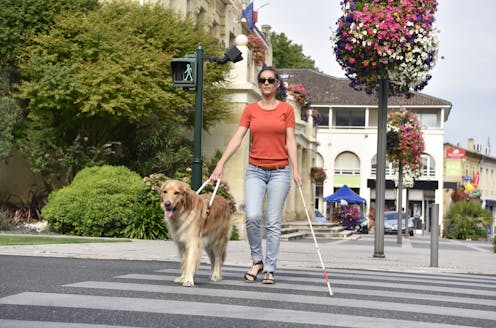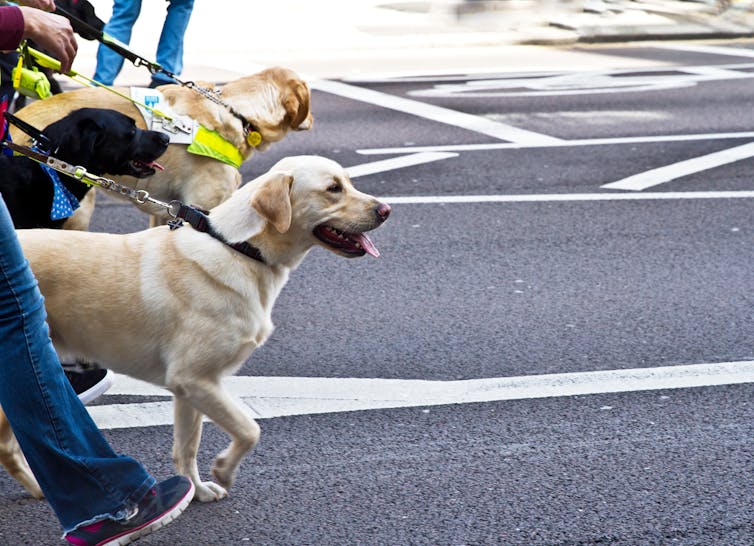 A lot of people may think a guide dog tells a person when they can cross the road. But this is not actually true.Shutterstock
A lot of people may think a guide dog tells a person when they can cross the road. But this is not actually true.ShutterstockHow do guide dogs know where their owners want to go? – Mia, age 6.
Mia, thank you for your question. I know a bit about this topic because I have some experience training and using an assistance dog myself. Also, as part of my job teaching at a university, I’m working with a number of students doing research projects on assistance dogs.
The answer to your great question is actually quite simple. Guide dogs, which are assistance dogs for people who are blind or vision impaired, know where to go because they practise.
Practice makes perfect – just like how you might learn to walk from home to school, or how adults know how to drive to different places without getting lost.
Read more: Curious Kids: is it true dogs don't like to travel?
As part of their training a guide dog will practise getting around to some of the most common places the person they will guide needs to go. This may include the shops near their home, or from their home to the bus stop.
So, in simple terms, guide dogs only know how to get to and from familiar places they have practised the routes for.
What most people don’t realise, though, is the person the dog is guiding still needs to know where they are going too.
 Just like people train for their jobs, dogs have to do special training to become guide dogs.From shutterstock.com
Just like people train for their jobs, dogs have to do special training to become guide dogs.From shutterstock.comIdentifying obstacles
There is a lot of training a guide dog will do before they are taught familiar places. This is because making sure they guide a person safely is much more than knowing where to go.
Say you are walking to school and the branch of a tree has fallen across the path you normally walk on.
If that branch was small you might just step over it. If it is big you might go around it or even cross to the other side of the road.
Since a blind person may not be able to see the branch, it’s up to their guide dog to let them know it is there. How they do this will depend on how big the branch is.
Read more: Curious Kids: why do pets have dark eyes while humans have mostly white eyes?
If it is small the dog may help safely guide the person around it. If it is large and they can’t get around easily, they will block the person so they know there is something in the way.
It is then up to the person to work with their dog to help them safely find a way past the branch.
This means a big part of being a guide dog is letting the person they are guiding know when there is an obstacle in their way.
To a blind person an obstacle can include things like the step down off the path onto the road, or a step up into a shop. These are things you probably don’t even think of as an obstacle when walking.
Training and team work are key for a guide dog and their human partners.Working as a team
A lot of people may think a guide dog tells a person when they can cross a road. But this is not actually true.
The dog will block the person from stepping onto the road to let them then know they have reached the end of the path.
It is then up to the person to listen to their surrounds and decide if it is safe to cross the road.
It is the person who tells the dog it is safe to cross the road – not the other way around.
Read more: Curious Kids: Why don't dogs live as long as humans?
Hello, curious kids! Have you got a question you’d like an expert to answer? Ask an adult to send your question to curiouskids@theconversation.edu.au
Carmel Nottle is affiliated with Animal Therapies Limited.
Authors: Carmel Nottle, Lecturer - Human Movement / Clinical Exercise Physiology, University of South Australia
Read more http://theconversation.com/curious-kids-how-do-guide-dogs-know-where-their-owners-want-to-go-125567
| < Prev | Next > |
|---|








